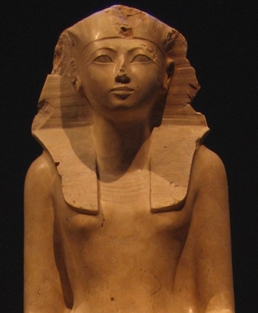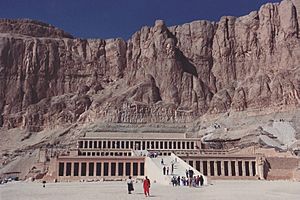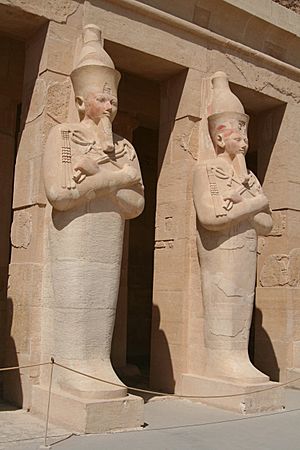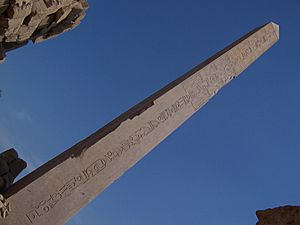Hatshepsut facts for kids




Hatshepsut (1507–1458 BC), meaning Foremost of Noble Ladies, was the fifth Pharaoh of the 18th dynasty of Ancient Egypt. She reigned longer than any other woman of an indigenous Egyptian dynasty.
Her father was Thutmose I. Her predecessor was Thutmose II (her brother and husband). Her successor was Thutmose III, her nephew, the son of Thutmose II by a lesser wife. Thutmose III was co-regent with his stepmother, and was head of the army, but Hatshepsut was named Pharaoh.
Today it is generally recognized that Hatshepsut assumed the position of Pharaoh. The length of her reign usually is given as twenty-two years. The third-century B.C. historian, Manetho, gave that figure of twenty-one years and nine months, and he had access to many records that now are lost. She died in 1458 BC, which means that she became pharaoh in about 1479 BC.
Contents
Early life and family
Hatshepsut was married to Thutmose II, her half-brother, when she was 14 or 15 years old. They were around the same age when they got married.
Hatshepsut had one daughter, Neferure, but no son. When her husband died about 1479 BC, the throne passed to his son Thutmose III, born to Isis, a lesser wife. As he was only three years old, Hatshepsut became the effective ruler.
Major accomplishments
Hatshepsut established the trade networks that had been disrupted during the Hyksos occupation of Egypt during the Second Intermediate Period.
Many Egyptologists have claimed that her foreign policy was mainly peaceful. However, there is evidence that Hatshepsut led successful military campaigns in Nubia, the Levant, and Syria early in her career. The conquered lands were taxed and looted, which made Egypt rich.
Building projects
Hatshepsut was one of the most prolific builders in ancient Egypt. She commissioned hundreds of construction projects throughout both Upper Egypt and Lower Egypt, that were grander and more numerous than those of any of her Middle Kingdom predecessors. Later pharaohs attempted to claim some of her projects as theirs.
She employed the great architect Ineni. He also had worked for her father, her husband, and for the royal vizier Senemut. During her reign, so much statuary was produced that almost every major museum in the world has Hatshepsut statuary among their collections. For example, the Hatshepsut Room in New York City's Metropolitan Museum of Art is made up of some of these pieces.
Following the tradition of most pharaohs, Hatshepsut had monuments built at the Temple of Karnak. At Karnak, she also restored the original Precinct of Mut, an ancient goddess of Egypt, that had been damaged by the Hyksos occupation. She had twin obelisks, at the time the tallest in the world, erected at the entrance to the temple. One still stands, as the tallest surviving ancient obelisk on Earth. The other has broken in two and fallen down.
As with many pharaohs, the masterpiece of Hatshepsut's building projects was her mortuary temple. She built hers in a complex at Deir el-Bahri. It was designed and implemented by Senemut at a site on the West Bank of the Nile River near the entrance to what now is called the Valley of the Kings. The focal point was the Djeser-Djeseru or "the Sublime of Sublimes", a structure of perfect harmony built nearly one thousand years before the Parthenon. Djeser-Djeseru sits on a series of agricultural terraces that once had lush gardens. Djeser-Djeseru is built into a cliff face that rises sharply above it. Djeser-Djeseru and the other buildings of Hatshepsut's Deir el-Bahri complex were significant advances in architecture. Another of her accomplishments is the Hatshepsut needle (the granite obelisk).
Amun
The Oracle of Amun proclaimed that it was the will of Amun that Hatshepsut be pharaoh, which strengthened her position. She showed Amun's support by having these proclamations by the god Amun carved on her monuments:
- "Welcome my sweet daughter, my favorite, the King of Upper and Lower Egypt, Maatkare, Hatshepsut. Thou art the Pharaoh, taking possession of the Two Lands".
Status
Women had a high status in ancient Egypt and enjoyed the legal right to own, inherit, and will property. However, a woman becoming pharaoh was rare. Before Hatshepsut, only Khentkaues, Sobekneferu, and Neferneferuaten were known to rule solely in their own name. Twosret, a female king and the last pharaoh of the nineteenth dynasty, may have been the only woman to rule Egypt after Hatshepsut.
Hatshepsut had been well trained in her duties as the daughter of the pharaoh. During her father's reign she held the powerful office of God's Wife. She was well experienced in the administration of her kingdom by the time she became pharaoh. No one tired to challenge her leadership.
Hatshepsut wore all of the regalia and symbols of the pharaonic office in official representations. Many existing statues show her in typically feminine clothes. Others show her in the royal ceremonial attire.
Notably, even after assuming the formal regalia, Hatshepsut still described herself as a beautiful woman, often as the most beautiful of women. Hatshepsut associated herself with the lioness image of Sekhmet, the major war deity in the Egyptian pantheon
Modern scholars think that by using the typical symbols of pharaonic power, Hatshepsut was asserting her claim to be the sovereign rather than a "King's Great Wife" or queen consort.
Death
Hatshepsut died in her 22nd regnal year. This was recorded on a single stela erected at Armant on 16 January 1458 BC. She was about 50 years old at that time. The cause of Hatshepsut's death is not known. There are theories that she might have died from cancer, or murdered by her stepson.
It is likely that when she died, she was buried in this tomb along with her father. Her mummy was missing from its sarcophagus when her tomb was excavated in the 1920s. Her body was never identified.
Her stepson and nephew Thutmose III, who had become head of the army, succeeded her.
Images for kids
-
A tree in front of the Mortuary Temple of Hatshepsut, claimed to have been brought from Punt by Hatshepsut's expedition, which is depicted on the temple walls
See also
 In Spanish: Hatshepsut para niños
In Spanish: Hatshepsut para niños






